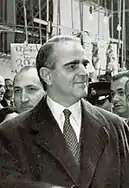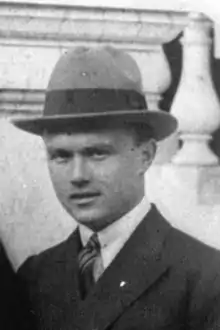1956 Greek legislative election
Parliamentary elections were held in Greece on 19 February 1956.[1] The result was a victory for Constantine Karamanlis and his National Radical Union party by securing the electoral vote despite trailing in the popular vote. It was the first general election in Greece in which women had the right to vote, although women had first voted in a by-election in Thessaloniki Prefecture in 1953 in which the first female MP was elected.
| |||||||||||||||||||||||||||||||
All 300 seats of the Greek Parliament 151 seats were needed for a majority | |||||||||||||||||||||||||||||||
|---|---|---|---|---|---|---|---|---|---|---|---|---|---|---|---|---|---|---|---|---|---|---|---|---|---|---|---|---|---|---|---|
| |||||||||||||||||||||||||||||||
| |||||||||||||||||||||||||||||||
| This article is part of a series on |
| Politics of Greece |
|---|
 |
|
|
Although the Liberal Democratic Union, a coalition of centrist parties, received a slim plurality of votes, the conservative governing party, the National Radical Union, won the most seats due to a complex and controversial electoral system enacted by Karamanlis. A "first past the post" system was applied in the rural constituencies where the ERE was expected to gain a plurality, while proportional representation was reserved for the urban constituencies, where the Liberal Democratic Union was expected to lead.[2][3] As a result, the Liberal Democratic Union came up 19 seats short of a majority.
The Liberal Democratic Union included the Liberal Party, led by Sophoklis Venizelos and Georgios Papandreou, as well as the left-wing EDA, led by Ioannis Passalidis. A few years later, Georgios Papandreou and Sophoklis Venizelos renounced their alliance with EDA, breaking up the Liberal Democratic Union.
Background
In 1955, Karamanlis was chosen by the King Paul I as successor of prime minister General Alexandros Papagos, who had just died. The decision was controversial, as Karamanlis was not a leading member of Papagos' party, and caused the vehement reactions of the party's two most prominent members, Stefanos Stefanopoulos and Panagiotis Kanellopoulos.
Nevertheless, Karamanlis, thanks to the support of the royal family and his own dextrous handlings, managed to establish himself as a strong leader. After stabilizing his leadership, he dissolved the Greek Rally party and created his own conservative right-wing party, the National Radical Union, which also comprised some prominent centrists (Evangelos Averoff, Panagiotis Kanellopoulos, Konstantinos Tsatsos) and went on to dominate the Greek political scene for the next 8 years.
Results
| Party | Votes | % | Seats |
|---|---|---|---|
| Liberal Democratic Union | 1,620,007 | 48.2 | 132 |
| National Radical Union | 1,594,112 | 47.4 | 165 |
| Progressive Party | 74,545 | 2.2 | 0 |
| List of Independents | 31,002 | 0.9 | 2 |
| Popular Social Party | 29,375 | 0.9 | 0 |
| Christian Democracy | 449 | 0.0 | 0 |
| Independents | 14,851 | 0.4 | 1 |
| Invalid/blank votes | 15,084 | – | – |
| Total | 3,379,425 | 100 | 300 |
| Registered voters/turnout | 4,507,907 | 75.0 | – |
| Source: Nohlen & Stöver | |||
References
- Dieter Nohlen & Philip Stöver (2010) Elections in Europe: A data handbook, p830 ISBN 978-3-8329-5609-7
- Eleftheria Newspaper, 22 May 2007, article on the history of election laws (in Greek)
- ""Το Βήμα" newspaper, 12 Nov 2000, "Δημοκρατία Διάτρητη" (In Greek)". Archived from the original on 2007-09-29. Retrieved 2007-08-26.

